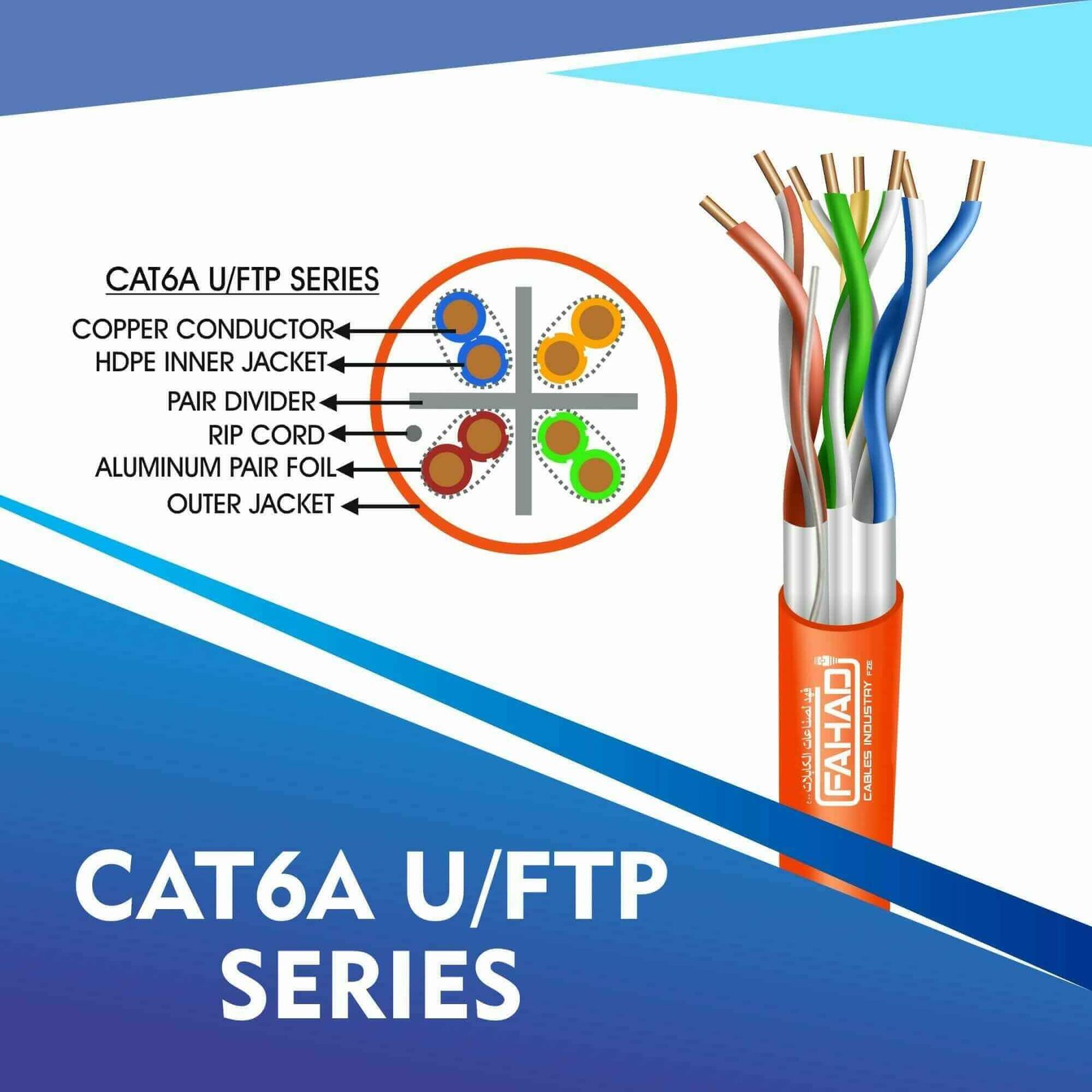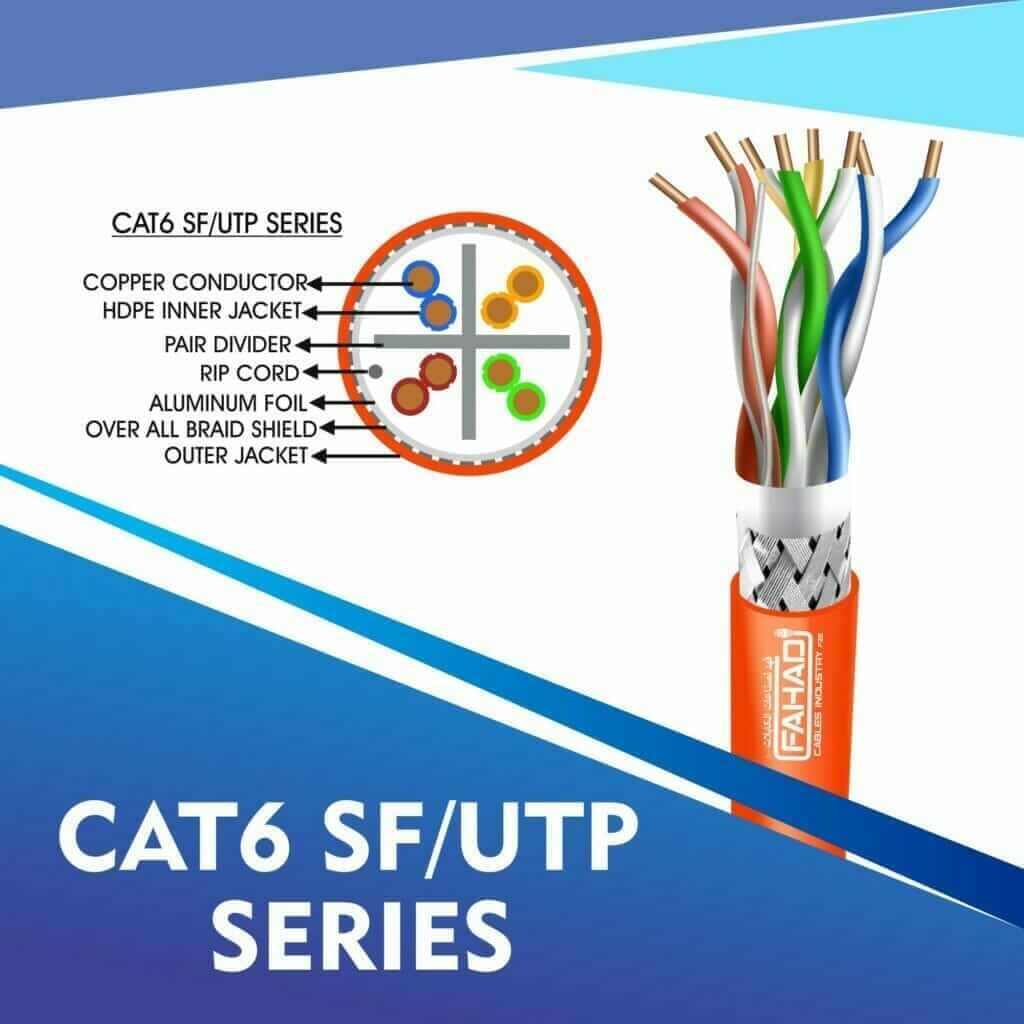Blog
Understanding cat 6 colour code & Cat6 Cable Color Code: Insights from Fahad Cables Industry FZE

Introduction to Cat6 Cables
Cat6 cables, or Category 6 cables, are a type of twisted pair cable that has become essential in modern networking, particularly in high-speed data transmission and internet connectivity. Designed to support Ethernet networks, Cat6 cables enhance the performance and speed needed for today’s demanding cat6 cable colors applications. cable length color code With a capability to transmit data at speeds of up to 10 Gbps over distances of 55 meters, they have surpassed their predecessors, such as Cat5 and Cat5e cables, by providing increased bandwidth and reduced crosstalk, thereby ensuring clearer communication.Cat6 Cable Color Codes.cat6 connector color code cat 6 wiring colours ethernet cable
The significance of Cat6 cables extends beyond mere speed; they play a crucial role in a variety of settings—from residential installations where high-speed internet cat6 colour order access is cat 6 patch cord color code paramount, to commercial environments that require robust and reliable data transmission infrastructures. Additionally, their strengthened design helps in minimizing interference and maintaining integrity during data transfers, which is vital for maintaining high network efficiency.cat 6 cable crimping colour code rj45 cable color code cat 6 colour code
copper cable color code
Understanding the color codes associated with Cat6 cables is essential for both installers and users. The color coding not only aids in the identification of each wire within the cable but also informs proper wiring connectivity in networking setups. This knowledge is particularly beneficial in organized installations, helping technicians troubleshoot potential issues with ease. Furthermore, a proper grasp category 6 cable color code of these color codes ensures adherence to standardized wiring practices, which is critical for maximizing performance efficiency in networking systems.utp cable rj45 color coding what is the color code for ethernet cable
As networking technology continues to evolve, the importance of Cat6 cables and their respective color codes is likely to grow, underscoring the need for advanced understanding among users and installers alike. This foundational knowledge is instrumental in fostering reliable and effective network communication.cat 6 wiring color code cat6 cable crimping colour code
Importance of Color Codes in Network Cabling
Color coding in network cabling is fundamental to maintaining an organized and efficient cabling system. The use of distinct colors for different wire pairs in Cat6 cables provides critical visual cues that assist in identifying communication pathways. By adhering to standardized color codes, brown wire technicians and engineers can using the t568b wiring standard on both ends of a cable would produce what type of network cable? easily correctly wired understand, install, and maintain complex network systems without confusion. This organization enhances efficiency, particularly in environments where multiple cables are present, such as data centers and office buildings.rj45 colour code cat 6 ethernet cable colors meaning
Identifying wire pairs is a key function of color coding. Each pair of wires within a Cat6 cable is typically assigned a specific color combination, such as blue with blue stripes, orange with orange orange stripes stripes, green with green stripes, and brown with brown stripes. Such a system facilitates proper termination, ensuring that the correct orange wire green pair blue pair pairs are connected, which is essential for efficient data transmission. Incorrect pairing can lead to latency, data loss, or complete network failure.
cat6a cable color code
In addition to aiding installation, cat6a cable color code color codes play a significant role in troubleshooting network issues. When problems arise, a color coded network cables well-organized cabling system allows technicians to quickly locate and identify potential faults. Issues such as broken connections or interference can be resolved more efficiently, reducing downtime and improving overall network reliability. Furthermore, clearly marked cables simplify the process of upgrading or expanding network systems, as technicians can trace and manage existing connections without the risk of causing further complications.cat6a cable color code cat six colour code
Overall, the systematic use of color codes in Cat6 network cabling significantly enhances the organization, efficiency, and reliability of a network. By following established color conventions, professionals in the industry can ensure proper installation and easy maintenance, thereby fostering a robust communication infrastructure. color code cat6
Fahad Cables Industry FZE: An Introduction
Established as a leading entity in the cable manufacturing sector, Fahad Cables Industry FZE has built a robust reputation for delivering high-quality products, notably in the domain of Cat6 cables. cat6 color code With its inception dating back over a decade, the company has progressively evolved to meet the growing demands of an increasingly digital world. The focus on innovation and adherence to international manufacturing standards has solidified its position as a reliable supplier for various industries, including telecommunications and data networking.
The mission of Fahad Cables Industry FZE centers on providing exceptional cable solutions that ensure optimum performance and durability. Committed to quality, the company implements rigorous testing protocols during production, ensuring that every product meets the stringent requirements set forth by industry standards. This unwavering commitment to excellence has fostered trust among clients, facilitating long-term partnerships and contributing to the brand’s success.
Fahad Cables Industry FZE: Pioneering Network Cable Manufacturing in the UAE
Introduction to Fahad Cables Industry FZE
Founded in the heart of the United Arab Emirates, Fahad Cables Industry FZE has established itself as a leading manufacturer of network cables, dedicated to serving a diverse clientele both regionally and globally. With its inception rooted in a vision to enhance communication infrastructure across the region, the company positions itself at the forefront of the evolving telecommunications landscape. Fahad Cables Industry FZE operates with a clear mission: to provide high-quality, reliable, and innovative cabling solutions that meet the ever-growing demands of the market.
The company’s manufacturing capabilities are extensive, featuring state-of-the-art technology and equipment that enable the production of a wide range of network cables, including data, power, and specialty cables. With a focus on sustainability and efficiency, Fahad Cables Industry FZE is committed to implementing stringent quality control measures throughout the production process. This commitment is evident in their adherence to international standards, ensuring that every product not only meets but exceeds client expectations.
cat6 b pattern
Fahad Cables Industry FZE boasts a skilled and dedicated workforce, comprising professionals with extensive experience in the cable manufacturing sector. This expertise is crucial in fostering a culture of innovation and excellence within the organization. The company’s facilities are strategically located to maximize operational efficiency, providing easy access to key markets and logistics hubs, thus streamlining the supply chain process.
Globally recognized for its superior product quality and customer service, Fahad Cables Industry FZE continues to expand its footprint in the telecommunications market. As the demand for reliable cabling solutions grows, the company’s focus on innovation and customer satisfaction solidifies its prominence in the industry, making it a trusted partner for businesses seeking robust networking solutions. Through continued investment in technology and talent, Fahad Cables Industry FZE is poised for sustained growth and success as it leads the charge in shaping the future of network connectivity.
Cat6 Cable Color Codes Explained
Cat6 cables, an upgraded version of the Cat5 standard, play a crucial role in various networking applications, supporting higher speeds and bandwidths. A key aspect of Cat6 cable functionality lies in its internal wiring structure, dictated by distinct color codes that align with the T568A and T568B wiring standards. Understanding these color codes is essential for proper installation and troubleshooting.cat6a color order
Each Cat6 cable consists of four twisted pairs of wires, each pair serving a specific purpose in data transmission. The standard color coding identifies these pairs—paired wires are typically arranged in the following sequence: Pair 1 with white/blue and blue wires, Pair 2 with white/orange and orange wires, Pair 3 with white/green and green wires, and Pair 4 with white/brown and brown wires. This structured arrangement ensures minimal interference and optimal performance, which is paramount in high-speed networks.cat6 cable color code meaning patch cable color code cat6 cable color code standarn ethernet cable codes
cat6 color sequence
The T568A and T568B standards dictate different arrangements for the same color-coded wires. The T568A standard follows the color sequence: Pair 1 (white/blue, blue), Pair 2 (white/green, green), Pair 3 (white/orange, orange), and Pair 4 (white/brown, brown). In contrast, the T568B standard reverses the order of the second and third pairs, resulting in Pair 1 (white/orange, orange), Pair 2 (white/green, green), Pair 3 (white/blue, blue), and Pair 4 (white/brown, brown). Though both standards achieve similar performance levels, consistency in wiring is key for network reliability.
In summary, properly understanding and utilizing the Cat6 cable color codes according to the T568A and T568B wiring standards is vital for effective networking. This knowledge aids in correct installations and seamless troubleshooting, reinforcing the critical role of structured cabling in today’s digital communication landscape.
Manufacturing Process of Cat6 Cables at Fahad Cables
ahad Cables Industry FZE was established with a clear vision to become a leading manufacturer of network cables in the United Arab Emirates. Founded by industry veterans who possess extensive experience in the cable manufacturing sector, the organization aims to meet the growing demands for high-quality cabling solutions that support the region’s continuous technological advancement. Since its inception, Fahad Cables has committed itself to innovation and quality, allowing it to carve out a significant niche in the competitive landscape of the cable industry.
The mission of Fahad Cables is to deliver superior performance and reliability in their products, ensuring that they meet the rigorous standards required for modern-day applications. With a strong emphasis on research and development, the organization integrates the latest technological advancements into its manufacturing processes. This commitment to excellence has enabled it to produce a diverse range of network cables that cater to various sectors, including telecommunications, construction, and information technology.
cat6 colour order
Furthermore, the product lineup includes coaxial cables, primarily used for cable television and internet connections. Designed to provide a reliable signal with minimal interference, coaxial cables are essential for various broadcasting and communication applications. Fahad prides itself on producing cables that adhere to international standards, ensuring reliability and safety.
In addition to their commitment to quality, Fahad’s products meet several industry certifications, thereby establishing a strong foundation of trust and safety in their offerings. With a focus on delivering excellence, Fahad Cables Industry FZE continues to lead the way in network cable manufacturing, catering to the dynamic needs of various sectors in the UAE and beyond.
Quality Standards and Certifications
Fahad Cables Industry FZE is committed to providing high-quality Cat6 cables that meet and exceed industry standards. To ensure that their products are reliable, safe, and effective, the organization adheres to a variety of quality standards and certifications that are recognized internationally. These certifications are crucial as they signify that the cables have been tested for performance and safety, instilling confidence in both distributors and end-users.
One of the primary standards adhered to by Fahad Cables is the ISO 9001 certification, which emphasizes the importance of a quality management system. This certification reflects the company’s dedication to continuous improvement and customer satisfaction in all processes, from manufacturing to ethernet cable color codes customer service. Additionally, compliance with the ANSI/TIA-568 standard ensures that their Cat6 cables meet essential telecommunication color in the cable industry performance criteria, fostering optimal data transmission rates and enhanced network reliability.





Moreover, Fahad Cables also complies with the standards set by Underwriters Laboratories (UL), which provides assurance that the products meet rigorous safety testing requirements. UL certification is a significant benchmark in the cable manufacturing industry, as it confirms that the Cat6 cables are safe for use and minimize risks associated with electrical hazards.patch panel color coding cat 6
Furthermore, adherence to the International Electrotechnical Commission (IEC) standards ensures that the cables are compatible with various telecommunications systems worldwide. This international recognition allows Fahad Cables to widen its market reach while maintaining product credibility.cat 6 color code rj45
In essence, the focus on stringent quality standards and certifications not only guarantees the reliability of Fahad Cables’ Cat6 products but also reassures customers that they are investing in a product that meets global safety and performance benchmarks.network cabling color code
Product Range and Quality Standards
Fahad Cables Industry FZE is recognized as a leading manufacturer of network cables in the UAE, offering a comprehensive range of products designed to meet various technological needs. Among the notable types of cables in their product lineup are CAT5e, CAT6, CAT6a, and fiber optic cables, each tailored for specific applications in residential, commercial, and industrial settings.
The CAT5e cables are an enhanced version of the traditional CAT5, designed to support higher data rates of up to 1 Gbps, making them ideal for home networks and small businesses. On the other hand, CAT6 and CAT6a cables provide greater performance capabilities, supporting up to 10 Gbps at distances of up to 55 meters for CAT6 and 100 meters for CAT6a. This makes them suitable for more demanding applications, such as data centers and enterprise networks, where higher bandwidth capacity is crucial.
In addition to copper cables, Fahad Cables Industry FZE also offers an extensive range of fiber optic cables. Fiber optic technology is acclaimed for its ability to transmit data over long distances with minimal loss, making it a preferred choice for telecommunications and internet service providers. The company’s fiber optic cables cater to various standards, ensuring versatility in installation and performance.
Quality assurance is a central tenet for Fahad Cables, as they adhere to rigorous international and local quality standards. The company ensures that its products undergo meticulous testing throughout the manufacturing process, acquiring certifications that reflect compliance with industry norms such as ISO 9001 and IEC standards. This commitment to quality guarantees that customers receive reliable and durable network cables that not only meet their immediate connectivity requirements but also withstand the demands of future technological advancements.
Tips for Selecting Cat6 Cables
When selecting Cat6 cables, several crucial factors must be considered to ensure optimal performance and reliability in network setup. One of the foremost considerations is the cable length. It is essential to choose the appropriate length to avoid signal degradation. Longer cables can lead to reduced performance, particularly beyond the recommended 100 meters. By evaluating your specific needs and measuring the distance from devices to routers or switches, you can determine the most suitable length.cat6 patch panel color code cat6 color coding for rj45
Another essential factor is the type of shielding. Cat6 cables are available in both unshielded twisted pairs (UTP) and shielded twisted pairs (STP). UTP cables are adequate for most residential environments, while STP cables provide extra protection against electromagnetic interference (EMI), making them preferable for industrial or densely populated areas. Selecting the right shielding based on your environment helps maintain signal integrity and speed.ethernet cabling color code
The reputation of the manufacturer is also a vital consideration. Opt for established brands known for their quality and reliability in producing Cat6 cables. Researching customer reviews and testimonials can provide insights into the performance of the cables and their durability. Additionally, ensure that the manufacturer complies with industry standards, such as the TIA/EIA-568 standards, which guarantees that the cables meet the necessary specifications for performance.cat6 rj45 color code
Furthermore, pay attention to the warranty offered by the manufacturer. A robust warranty indicates the manufacturer’s confidence in the product’s quality. It also protects your investment, giving you peace of mind should any issues arise after purchase. Evaluating warranty options can assist in determining the best Cat6 cable that meets both budget and performance requirements. cat6 color order
Conclusion and Future of Cat6 Cables
Understanding the color codes associated with Cat6 cables is crucial for anyone involved in network setup and management. These codes serve as a systematic guide that enhances clarity during installations and troubleshooting. Adequate knowledge of these color codes not only prevents potential errors but also promotes efficient communication among network professionals. As networking demands continue to evolve, familiarity with these standards equips individuals with the necessary skills to implement and maintain robust network solutions.
Looking ahead, the future of Cat6 cables, as well as other networking cables, is poised to witness significant advancements. With the rapid adoption of higher data rates and increased bandwidth requirements, there is a growing need for cables that can support these demands. Innovations such as improved insulation materials and advanced manufacturing techniques are being explored, which may lead to enhanced performance and durability. Furthermore, the shift towards fiber-optic technology is likely to influence the development of traditional copper cables like Cat6, compelling the industry to rethink their design and applicability in various settings.
Additionally, the continual improvement of networking protocols and standards will play a vital role in shaping the Cat6 cable landscape. Future variations, such as Cat6a and Cat7, will likely incorporate new technologies that ensure higher performance levels. Such advancements in network infrastructure are essential for supporting emerging technologies, including the Internet of Things (IoT), 5G, and smart home applications. Overall, staying informed about the color codes and ongoing innovations in networking cables will be crucial for professionals, ensuring that they are well-prepared to meet the dynamically evolving standards in the telecommunications industry.

